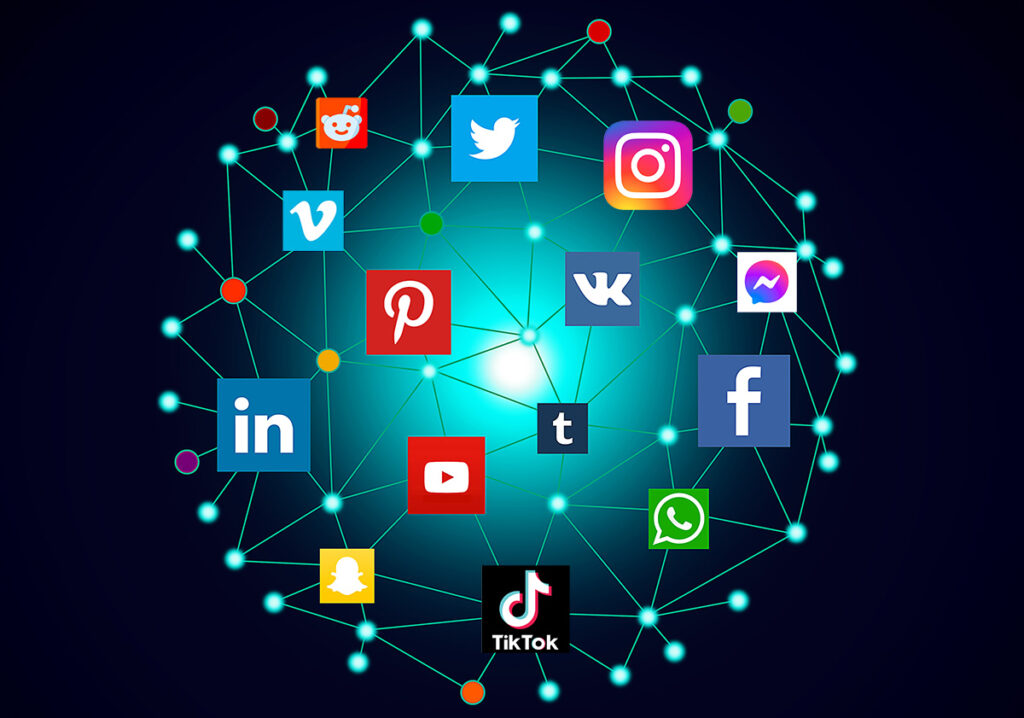Social Media Technology refers to the digital tools, platforms, and systems that enable people to create, share, interact with, and consume content — and to build relationships in a virtual environment.
At its core, Social Media Technology is the underlying software and hardware infrastructure that powers online social interaction, content sharing, and community formation through real-time digital networks.
Components of Social Media Technology
1. Software Platforms
-
Examples: Witanworld, Facebook, Instagram, Twitter (X), TikTok, YouTube, LinkedIn
-
Built using:
- Front-end frameworks (React, Flutter)
- Back-end systems (Node.js, Django, Java)
- APIs and SDKs (e.g., Meta Graph API)
2. Databases & Storage
-
Store user profiles, content, likes, comments, messages, etc.
-
Use:
- Relational DBs (PostgreSQL, MySQL)
- NoSQL (MongoDB, Cassandra)
- Cloud storage (AWS S3, Google Cloud Storage)
3. AI & Machine Learning
- Drives personalized feeds, recommendations, ad targeting, spam detection, and content moderation.
- Examples: TikTok’s For You page, YouTube’s recommendation engine.
4. Multimedia & Streaming Tech
- Compression, real-time delivery, rendering for:
- Photos, videos, live streams, AR filters.
- Formats: MP4, HLS, WebRTC, AV1
5. Networking & Infrastructure
- CDNs (Content Delivery Networks) for fast global content delivery
- Load balancers, edge computing, and real-time APIs (like GraphQL or WebSockets)
6. Authentication & Identity
- Login systems (email, phone, OAuth via Google/Facebook)
- Identity verification (KYC), multi-factor authentication, digital wallets (in Web3 social)
7. Analytics & Engagement Metrics
- Tracks user behavior: impressions, CTR, likes, shares, dwell time, engagement score
- Used for both UX design and ad monetization
The Future of Social Media Platforms (2025–2035)
1. From Engagement to Intelligence
- Today: Likes, shares, short-term dopamine
- Future: Platforms that learn with the user, not just about them
- How:
- Personalized AI agents
- Context-aware content
- Real-time collaborative learning tools
- Example: Instead of scrolling memes, you’re co-creating knowledge with AI tutors, peers, or experts in real-time.
2. User-Owned Platforms (Web3 Shift)
- Today: Centralized control, your data = their product
- Future: Users own identity, data, and content
- Tech Backbone:
- Blockchain
- Decentralized identity (DID)
- Token economies (incentivizing creation & governance)
- Outcome: People become stakeholders, not just users.
3. Multi-Dimensional Identities
- Today: One profile per person
- Future: Multiple personas for different spaces — professional, creator, learner, etc.
- Impact:
- Privacy & control
- Purpose-specific feeds
- Emotional & context-aware AI interaction
4. Community-First Design
- Today: Broad audiences, minimal depth
- Future: Niche, high-trust micro-communities with shared values or goals
- Built-in tools:
- DAO-style moderation
- Custom governance rules
- Revenue/impact sharing for contributors
5. AI-Native Platforms
- Features:
- Real-time content generation (video, image, text)
- AI assistants that summarize, teach, coach, mentor
- Personalized feeds trained by user intent, not just behavior
6. Interoperability & Open Ecosystems
- Future: One identity, many worlds — users flow across platforms seamlessly
- Driven by:
- Protocols like ActivityPub, Lens, AT Protocol
- Portable social graphs and content
- Advantage: Users keep their reputation and community wherever they go
7. Purpose + Impact Integration
- Trend: Social platforms become action networks — not just talk, but transformation
- Examples:
- Climate action campaigns
- Learn-to-earn systems
- Verified impact badges (like GitHub for good)
8. Immersive + Ambient Social
- AR/VR Integration: Live, persistent virtual spaces (metaverse-ready)
- Ambient social: Low-friction updates, AI-curated presence without active input
- Example: Smart glasses showing your friend’s status or knowledge tip as you walk by
9. Ethical Design and Digital Wellbeing
- Future: Platforms will be auditable, ethical, and trust-centric
- Tech tools:
- AI explainability
- Consent-based data models
- Bias-mitigation layers
- Why it matters: Platforms that earn trust will win the decade
Final Thoughts: The Future of Social Media Platforms
The world is evolving from scrolling to solving, from engagement to empowerment, and from centralized control to user sovereignty. The next wave of social media platforms will be defined not by how many people they connect, but by how meaningfully they help them grow, learn, and act.
Key Takeaways:
- AI will power the experience — but humans will guide the intent.
- Decentralization will return power to the creators and communities.
- Purpose will replace vanity as the new metric of influence.
- Trust, transparency, and digital ethics will separate leaders from laggards.
- Immersive, personalized, and multi-modal interfaces will redefine what ‘social’ even means.
Platforms like WitanWorld are perfectly positioned to go beyond social media — toward building the future of intelligent human connection.
Not just a network. A new way of thinking, learning, collaborating, and transforming the world.








Leave a Reply